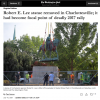Darnella Frazier, the teenager whose cellphone footage of Derek Chauvin murdering George Floyd last year sparked a racial reckoning in the United States, said Tuesday that her uncle was killed in a car crash involving a Minneapolis police vehicle that was pursuing a robbery suspect.
Leneal Lamont Frazier, 40, was in his car when it was struck by Minneapolis police while they were in a high-speed chase with another vehicle on the north side of the city. The victim, who was later identified by Darnella Frazier as her uncle, was not being pursued by police, authorities said.
“MINNEAPOLIS police Killed my uncle. … Another Black man lost his life in the hands of the police!” she wrote on
Facebook. “Minneapolis police [have] cost my whole family a big loss … today has been a day full of heartbreak and sadness.”
The Minnesota State Patrol announced that it is investigating the incident. As part of the inquiry, the force will look into whether the police car followed department policy and activated its emergency lights and siren during the chase.
“When completed, the State Patrol [will] turn its findings over to the county attorney for review,” Bruce Gordon, a spokesman for the Minnesota Department of Public Safety, told The Washington Post.
Around 12:30 a.m. Tuesday, police were pursuing a driver in a stolen vehicle who had been linked to several robberies and carjackings, Minneapolis Police Department spokesman John Elder said to The Post. As officers attempted a traffic stop, the driver fled, police said, leading to an eight-block pursuit on a residential road.
When a police car entered the intersection at 41st and Lyndale avenues north in the Camden neighborhood, the vehicle collided with a car that Darnella Frazier says was driven by her uncle. Three cars were involved in the wreck.
Resident Michael Ganzer told
WCCO that the crash “shook” his house as he was watching television.
“It was just a big, loud bang,” he said.
Leneal Frazier was taken to a hospital, where he was pronounced dead. A photo shared by his niece on
Facebook shows his mangled Jeep after it crashed into a tree.
The officer involved in the crash was also taken to a hospital but was later released with non-life-threatening injuries, Elder said. The suspect being pursued by police, who was not involved in the crash, remained at large as of early Wednesday.
Leneal Frazier’s daughter, Lanesha Frazier, told
KMSP that her father was on his way to see his girlfriend at the time of the crash.
“This is not fair, not right,” she said. “I didn’t expect that to be my father.”
Although there are stoplights at the intersection, police would not say who had the right of way at the time of the crash.
More than 7,000 deaths were the result of fatal crashes during police pursuits between 1996 and 2015, according to a
2017 report from the Justice Department’s Bureau of Justice Statistics. Seventy-two happened in Minnesota during that time period, the report found.
Darnella Frazier was 17 when she recorded the video that captured Floyd under Chauvin’s knee, showing Floyd’s dying moments as he pleaded for his mother near the Cup Foods convenience store in May 2020. The video from Frazier, who later testified in Chauvin’s trial, significantly contradicted the initial police account, which asserted that officers “noted he appeared to be suffering medical distress” after they handcuffed him and that he died in a hospital after being taken there by ambulance.
The video, which was described by one legal analyst as “the strongest piece of evidence I have ever seen in a case against a police officer,” sparked outrage in Minneapolis and around the world. Chauvin was convicted of murder and manslaughter in April and
sentenced to 22½ years in prison last month.
Frazier, who was awarded a
special citation by the Pulitzer Prize board last month for “courageously reporting the murder of George Floyd,” said she was shattered when she found out her uncle had died. She questioned why police were involved in a high-speed chase on a residential road.
“We went to the spot he was killed at and put beautiful flowers and candles, but even that’s not enough to bring him back,” she wrote. “It’s not fair how the police can just go around killing people.”

She shared a
GoFundMe page created to help pay for her uncle’s funeral expenses. He had six children and one grandchild, according to the fundraising page, and was remembered as a “protector” who loved family, friends and barbecuing.
His sister, Cheryl Frazier, is also looking for answers.
“He was a very good person. He would help you if you needed help. He’ll give you the shirt off his back if he had to,” she told WCCO. “He was always that type of person.”
Amia Lovelady, who said her mother was his girlfriend, said she did not know he was the one who died until hours later.
“It’s just so sad because we literally just talked to him. It’s just so crazy,” Lovelady told KMSP. “The car was just so smashed.”
In her Facebook post, Darnella Frazier shared a photo of her uncle as well as an image of an exchange of text messages between the two in which her uncle said he missed her and loved her. She wrote that had she known that their most recent time together at the beach would be their last, “I would’ve hugged you so much longer, told you I love you way harder.”
“It’s just hard for me to accept I won’t see you again,” she wrote.















